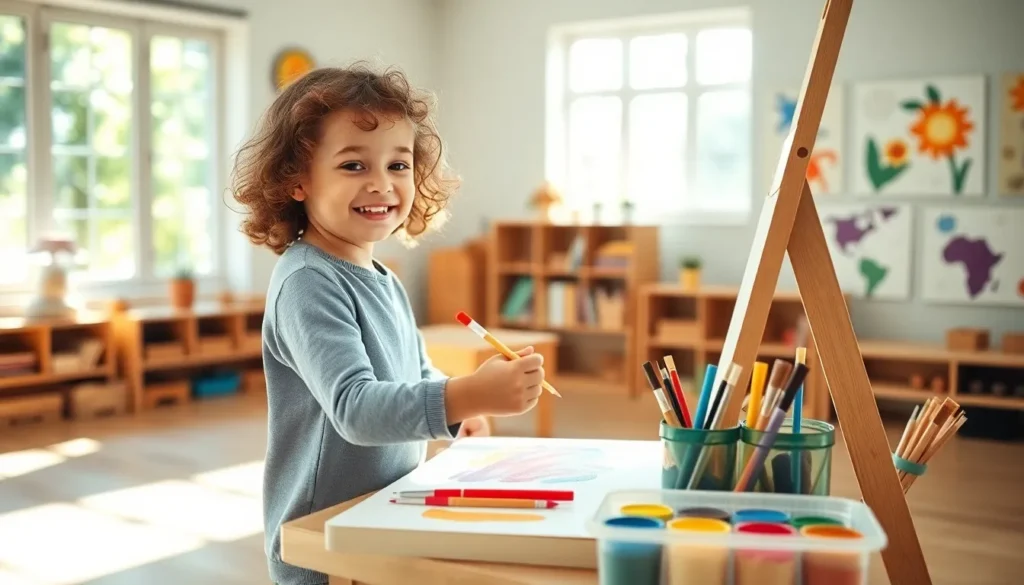Table of Contents
ToggleIn a world where creativity often takes a backseat to standardized tests, Montessori art materials are like a breath of fresh air for young minds. They’re not just tools; they’re gateways to self-expression, imagination, and a sprinkle of artistic chaos. Imagine a classroom where kids can explore their inner Picassos without the fear of a messy paint spill—sounds like a dream, right?
Overview of Montessori Art Materials
Montessori art materials play a crucial role in promoting creativity and self-expression in children. These tools allow young learners to dive into artistic exploration and develop their skills in an encouraging environment.
Importance in Montessori Education
Montessori education emphasizes hands-on learning, and art materials significantly enhance this approach. These materials boost creativity, which contributes to cognitive development. Children are encouraged to make choices, fostering independence and decision-making skills. Artistic activities help improve fine motor skills, allowing them to manipulate tools and materials effectively. Positive experiences with art create a sense of accomplishment, building self-esteem.
Types of Montessori Art Materials
Montessori art materials encompass a wide variety of tools and supplies. Paints include watercolors, tempera, and acrylics, allowing for different expressions in color and technique. Brushes range in size and style, enabling various brush strokes and textures. Drawing instruments such as crayons, colored pencils, and pastels support fine motor development and creativity. Cutting tools like safety scissors introduce children to more complex tasks while developing hand strength. Collage materials consist of paper, fabric, and natural elements, encouraging creative combinations. These elements inspire artistic discovery and nurture a passion for creativity.
Benefits of Using Montessori Art Materials

Montessori art materials offer numerous benefits that enhance children’s learning and development. They play a vital role in cultivating essential skills like creativity, fine motor control, and self-expression.
Enhancing Creativity and Self-Expression
Art materials foster an environment for children to explore their unique creativity. Children can choose from various paints, brushes, and drawing tools, allowing them to create work that reflects their individuality. These choices encourage imagination, inspiring kids to think beyond conventional limits. Engaging in artistic activities supports emotional expression. Artistic endeavors often become a means for children to articulate their thoughts and feelings to others. Experiencing the freedom to create without judgment enhances their confidence in expressing themselves.
Promoting Fine Motor Skills
Fine motor skills develop through hands-on experiences with art materials. Activities such as painting, cutting, and drawing engage small muscle groups, contributing to dexterity and coordination. Reaching for brushes or manipulating scissors helps strengthen hand-eye coordination. Regular practice with these materials enables children to refine their grip and control over tools. Improved motor skills extend beyond art, enhancing children’s performance in various everyday tasks. Mastering these skills creates a sense of achievement, further boosting their confidence and willingness to explore.
Key Characteristics of Montessori Art Materials
Montessori art materials exhibit distinct characteristics that support children’s creative development. These characteristics focus on safety, accessibility, and the promotion of independence.
Natural and Non-Toxic Materials
Natural materials like wood, cloth, and clay stand at the forefront of Montessori art supplies. They foster sensory experiences that synthetic materials often lack. Non-toxic paints and adhesives ensure safety during artistic exploration. Teachers choose materials that encourage creativity while eliminating harmful substances. Such choices promote peace of mind for parents and educators alike. The emphasis on eco-friendly options further nurtures children’s respect for the environment. These characteristics facilitate safe experimentation, enabling children to engage fully with their artistic expressions.
Child-Sized Equipment
Child-sized equipment plays a crucial role in the Montessori approach to art. Tools designed specifically for young hands enhance comfort and usability. Items like smaller brushes, scissors, and easels match children’s physical dimensions, making artistic tasks manageable. Access to appropriately sized tools builds confidence, empowering children to explore their creativity without frustration. This design consideration supports independence as children learn to handle materials with control. With each artistic endeavor, the child develops a sense of ownership, fostering both creativity and personal growth.
Implementing Montessori Art Materials in the Classroom
Creating an effective space for artistic exploration enhances children’s creativity. An organized art area encourages engagement and independence.
Setting Up an Art Area
Designing an inviting art area promotes creativity and focus. Use small tables and child-sized chairs to ensure comfort and accessibility. Arrange materials within reach, encouraging children to select their tools independently. Incorporate natural light to enhance the workspace and inspire creativity. Label storage containers with images or words, helping children identify materials and fostering responsibility. Frequent rotation of supplies keeps the space fresh and exciting, maintaining children’s interest in artistic activities. These thoughtful arrangements results in a welcoming environment where creativity thrives.
Selecting Age-Appropriate Materials
Choosing age-appropriate art materials nurtures children’s artistic development. Start with non-toxic paints, which allow for safe exploration of colors and textures. Introduce brushes and drawing instruments suited for small hands, enhancing control and dexterity. Include varied materials like clay, scissors, and collage items to spark imaginations. Select tools that match developmental stages, ensuring that materials challenge rather than frustrate children. Providing diverse options fosters choice and self-expression, allowing for personalized artistic journeys. In this way, curated selections support creativity while respecting children’s unique abilities and interests.
Montessori art materials are essential in nurturing creativity and self-expression in young children. By providing a rich environment filled with diverse tools, these materials empower kids to explore their artistic potential freely. The emphasis on accessibility and safety ensures that children can engage confidently in their artistic endeavors.
As they create, children develop vital skills like fine motor control and decision-making. This hands-on approach not only fosters independence but also builds self-esteem and emotional expression. Ultimately, incorporating Montessori art materials into educational settings cultivates a lifelong passion for creativity, enriching children’s lives and enhancing their learning experiences.


